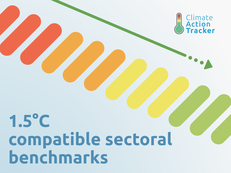Publications (China)
Three key near-term actions could bend the warming curve; bringing projected warming below 2˚C
Key findingsTripling renewables, doubling energy efficiency and cutting methane by 2030 and beyond would cut warming rate by a third in ten years, and halve it by 2040.It would cut projected warming this century significantly (about 0.9˚C from 2.6˚C to 1.7˚C).Scaled up financial support to achieve this will be needed read more...
As the climate crisis worsens, the warming outlook stagnates
Despite an escalating climate crisis marked by unprecedented wildfires, storms, floods, and droughts, our annual global temperature update shows global warming projections for 2100 are flatlining, with no improvement since 2021. The aggregate effect of current policies set the world on a path toward 2.7°C of warming.This three-year standstill underscores read more...
Decarbonising road transport: light-duty vehicles
The broad strokes of a Paris Agreement-aligned roadmap are clear: we need to roughly halve emissions by 2030, achieve net zero CO2 emissions by 2050 and net zero greenhouse gas emissions soon after. However, the details at the national and sectoral level are often still unclear. In this report, the read more...
Decarbonising steel: national circumstances and priority actions
Iron and steel production currently contribute around 7-8% of global greenhouse gas (GHG) emissions, so decarbonising this sector is fundamental to reaching net zero and meeting the Paris Agreement's 1.5°C warming limit.While decarbonising the steel sector is now technically feasible, different countries face different challenges in making this happen at read more...
Pulling the plug on fossils in power
Decarbonising the power sector is a key step on the road to net zero as it will cut both power sector emissions and help push fossil fuels out of the buildings, transport and industrial sectors as these sectors electrify.To help track global and country level progress, the Climate Action Tracker read more...
Paris-aligned benchmarks for the power sector
As the world moves to address the climate crisis and journey towards a zero-carbon future, roadmaps which demonstrate the pathway to cut emissions fast, fairly and effectively are essential.The broad strokes of a Paris-aligned roadmap are clear – we need to roughly halve emissions by 2030, achieve net zero CO2 read more...
Global update: Paris Agreement Turning Point
The recent wave of net zero targets has put the Paris Agreement’s 1.5°C within striking distance. The Climate Action Tracker (CAT) has calculated that global warming by 2100 could be as low as 2.1°C as a result of all the net zero pledges announced as of November 2020. Included in read more...
Global update: Pandemic recovery with just a hint of green
In this briefing, we examine the COVID-19 recovery packages of five major emitters – China, EU27, India, South Korea and the USA; we present the global temperature update, taking into account the economic impact of COVID-19; and we share key insights from the updated assessments for 13 of the 36 read more...
Paris Agreement Compatible Sectoral Benchmarks
We updated our power sector benchmarks in 2023. The report is available here. While national emission trends are a useful tool for measuring government progress towards meeting the Paris Agreement 1.5˚C temperature limit at a global level, each government will have to address its own sectors, each with their own, read more...
A government roadmap for addressing the climate and post COVID-19 economic crises
The COVID-19 pandemic presents the world with an unprecedented policy challenge: not only will it have a severe impact on the global economy likely to exceed that of both the 2008-09 Global Financial Crisis and the Great Depression, it will take place against the backdrop of the ongoing climate crisis.In read more...
Stay informed
Subscribe to our newsletter






